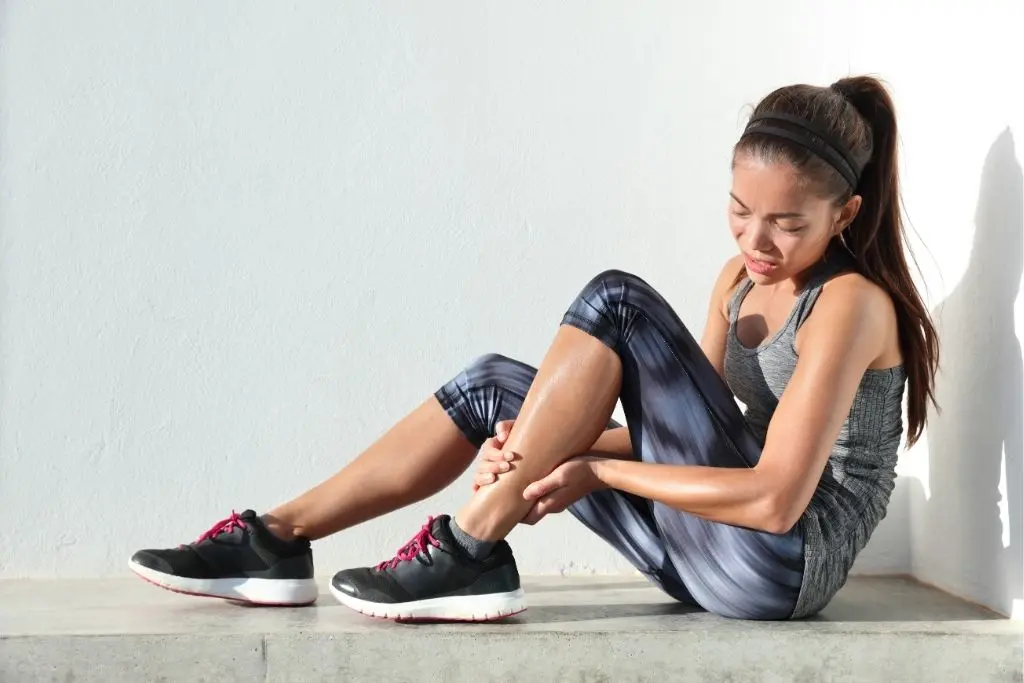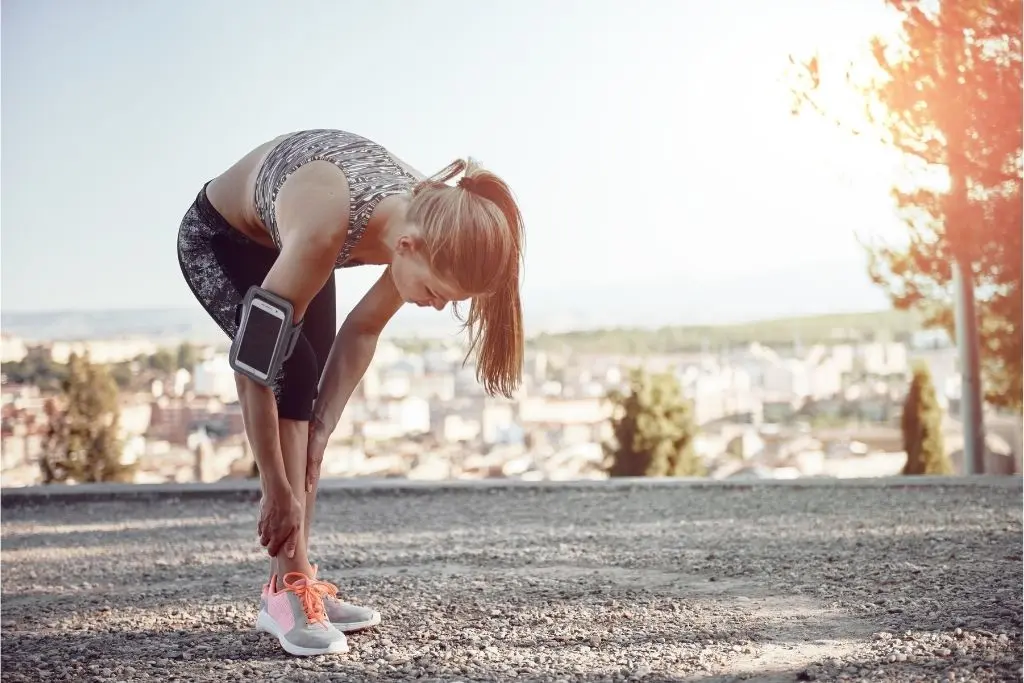What Causes Shin Splints And How Do You Prevent Them?

October 24, 2023 - Updated October 24, 2023

If you’ve never experienced shin splints before, count yourself lucky! Imagine being in the middle of an intense workout or flying through a run, feeling that endorphin rush and jamming to the beat of your favourite playlist, only to feel a pain building in the front of your shins. By the time your session has come to an end, you’re struggling to walk normally and in the days to follow, the pain still won’t let up, even when you’re out for a leisurely stroll.
Although there’s no overnight remedy for dreaded shin splints, there are definitely things you can do to promote faster recovery and prevent this common injury from happening in the first place.
What are shin splints?
According to The American Academy of Orthopedic Surgeons, the term shin splints refers to pain running along the inner edge of your shinbone or tibia. Also known as medial tibial stress syndrome, shin splints occur when the muscles, tendons and bone tissue around your tibia become inflamed.
John Hopkins Medicine says while the pain is often felt on the front and outside of your shin and first felt when your heel touches the ground during running, it can also start on the inside of your lower leg above your ankle, getting worse when you stand on your toes or roll your ankle inwards.
As bad as shin splints can feel, the good news is they typically aren’t a serious injury and will heal on their own with proper rest and recovery.

What causes shin splints?
Shin splints are most commonly experienced by runners, dancers and athletes, but they can develop for anyone after physical activity, especially if it’s vigorous, high impact or you’ve suddenly increased the intensity or frequency of your sessions. As the Cleveland Clinic explains, running or jumping movements can cause frequent or repetitive stress on the muscles and connective tissues on your shin bone. As a result, your shin bone can become inflamed and weakened.
Suddenly increasing the number of days you exercise can increase your risk of shin splints, as can dramatic increases in the duration or intensity of your workout sessions. If you’re someone who usually runs three miles on flat terrain and suddenly switch to six-mile runs or you love low-impact workouts and quickly make high-impact workouts the focus of your routine, you could be setting yourself up for much more pain than you bargained for.
Beyond the impact of different training styles or dramatic changes to your workout routine, footwear can also make a big difference. Wearing worn out or unsupportive shoes, the wrong shoes for your feet, or improper shoes for your training style can all increase your risk of shin splints.
How to get rid of shin splints
The number one treatment for shin splints is simple - rest. If you’re someone who leads an active lifestyle or is trying to achieve a fitness goal, we understand that extended rest can be challenging and feel like a setback, but it’s absolutely essential. Without adequate rest, you can risk your shin splints developing into a stress fracture (a small crack in your tibia caused by stress and overuse), meaning more pain and an even longer recovery time.
If it doesn’t hurt to do so, The American Academy of Orthopedic Surgeons says you may be able to continue exercising by sticking to low-impact training styles such as swimming or cycling, but rest is always the best medicine here. Listen to your body, don’t try to push through the pain, and if you’re not sure what’s right for you, don’t hesitate to see your doctor for advice.
Depending on your level of pain and/or swelling, you may want to take over-the-counter nonsteroidal anti-inflammatory medication such as aspirin or ibuprofen. Ice or cold packs, compression and gentle stretching can also ease the pain and support your recovery.
With proper recovery, shin splints usually heal within a couple of weeks, but depending on the severity and your level of rest, in some cases they can take months to heal. If you’re noticing significant redness or swelling, have been resting and are not seeing any improvement after a few weeks, or your shin splints are becoming worse, it’s always best to see your healthcare provider.

How to prevent shin splints
One of the easiest ways to avoid getting shin splints is to always increase your training gradually. Whether you’re increasing your weekly workout frequency, your running distance, your speed, or the amount of high-impact training you do, the Cleveland Clinic recommends making those increases in small increments with enough rest in between to let your body adapt.
If shin splints are a recurring issue for you, it could be worth sticking to low-impact training styles, such as swimming, cycling, Pilates and strength training. Want to sacrifice the impact without sacrificing the difficulty? Kelsey Well’s PWR Strength program is proof that low-impact training doesn’t mean easy.
Regardless of your preferred training style, be sure to take the time for a proper warm-up before each session, stretch afterwards, and consider investing in better footwear. Shoes designed for running are very different to shoes designed for HIIT workouts, just as shoes designed for flat feet are very different to those best-suited to high arches. The right type of foot support can be a gamechanger.
On the topic of footwear, Mayo Clinic suggests using arch supports if you have flat feet and to keep track of your mileage if you’re a runner, as you should be replacing your sneakers about every 350-500 miles (560-800 kilometers). Incorporating strength training in your routine can also help to strengthen and stabilise your legs and ankles in particular, or if you’re doing a significant amount of running or high-impact trying, try cross-training with low-impact workout options to mix it up and look after your body.
Recently had shin splints and want to do everything in your power to avoid getting them again? The same advice applies when we talk about gradually increasing your training. Take it gently and slowly, paying close attention to signals from your body and continuing to prioritise rest. If the pain returns, stop exercising immediately, rest, and take it as a sign that your body still needs a lower intensity or lower level of impact.
Shin splints are a common but painful fitness setback that so many of us have experienced (painfully endured is more fitting, let’s be honest), but they don’t have to be a common occurrence on your fitness journey. Listen to your body, take any training increases at a gradual pace, warm up properly, don’t overdo it with high-impact training, and make friends with rest and recovery to stay injury-free.

Erin is a writer and editor at Sweat with years of experience in women's publishing, the fitness industry, media and tech. She's passionate about the power of movement, and you can often find her on a yoga mat, a hike, a dance floor, in the ocean or the gym.
* Disclaimer: This blog post is not intended to replace the advice of a medical professional. The above information should not be used to diagnose, treat, or prevent any disease or medical condition. Please consult your doctor before making any changes to your diet, sleep methods, daily activity, or fitness routine. Sweat assumes no responsibility for any personal injury or damage sustained by any recommendations, opinions, or advice given in this article.
Fitness